When I Upload a Avatar to Vrchat It Is Stuck at Uploading Unity Package
Importing a model with non-humanoid (generic) animations
Importing a model with humanoid animations
This page contains guidance on importing a model for use with Unity'south Animation Organization. For information on creating a model for utilize with the Animation Organization, see Creating models for animation.
The Animation System works with two types of models:
- A Humanoid model is a specific structure, containing at least 15 basic organized in a style that loosely conforms to an actual human skeleton. This page contains guidance on importing this type of model.
- A Generic model is everything else. This might be anything from a teakettle to a dragon. For information on importing this type of model, see Importing a model with not-humanoid (generic) animations.
For full general importing guidance that is applicative to all types of models, see Importing a model.
Overview
When Unity imports Model files that incorporate Humanoid Rigs and Animation, information technology needs to reconcile the bone construction of the Model to its Animation. Information technology does this by mapping each bone in the file to a Humanoid Avatar so that it can play the Animation properly. For this reason, it is important to carefully ready your Model file A file containing a 3D information, which may include definitions for meshes, bones, animation, materials and textures. More than info
Encounter in Glossary before importing into Unity.
- Define the Rig type and create the Avatar.
- Right or verify the Avatar's mapping.
- Once you are finished with the bone mapping, you tin can optionally click the Muscles & Settings tab to tweak the Avatar's muscle configuration.
- Yous can optionally save the mapping of your skeleton'due south bones to the Avatar equally a Human Template A pre-divers os-mapping. Used for matching bones from FBX files to the Avatar. More info
See in Glossary (.ht) file. - Yous tin can optionally limit the animation that gets imported on certain bones by defining an Avatar Mask.
- From the Animation tab, enable the Import Animation option and then set the other Nugget-specific properties, .
- If the file consists of multiple animations or deportment, you can define specific action ranges as Blitheness Clips.
- For each Animation Prune Animation data that tin be used for animated characters or simple animations. It is a simple "unit" piece of motion, such as (one specific instance of) "Idle", "Walk" or "Run". More info
See in Glossary defined in the file, you lot can:- Alter the pose and root transform
- Optimize looping
- Mirror the animation on both sides of the Humanoid skeleton.
- Add curves to the clip in order to breathing the timings of other items
- Add events to the clip in order to trigger sure actions in time with the animation
- Discard part of the blitheness similar to using a runtime Avatar Mask but practical at import time
- Select a unlike Root Motion Node to drive the activeness from
- Read any messages from Unity about importing the clip
- Watch a preview of the animation prune
- To save your changes, click the Apply push at the lesser of the Import Settings window or Revert to discard your changes.
Set upward the Avatar
From the Rig tab of the Inspector window, prepare the Blitheness Type to Humanoid. By default, the Avatar Definition property is set to Create From This Model. If you continue this choice, Unity attempts to map the set of basic defined in the file to a Humanoid Avatar.

In some cases, you can change this pick to Copy From Other Avatar to apply an Avatar you already defined for some other Model file. For instance, if y'all create a Mesh The main graphics primitive of Unity. Meshes make upward a large part of your 3D worlds. Unity supports triangulated or Quadrangulated polygon meshes. Nurbs, Nurms, Subdiv surfaces must be converted to polygons. More than info
See in Glossary (peel) in your 3D modeling application with several distinct animations, y'all can export the Mesh to 1 FBX file, and each blitheness to its own FBX file. When you import these files into Unity, y'all only need to create a single Avatar for the first file you import (usually the Mesh). As long as all the files use the same bone structure, you can re-use that Avatar for the rest of the files (for example, all the animations).
If you enable this option, you must specify which Avatar you want to use by setting the Source property.
You can also modify the maximum number of basic that can influence a given vertex with the Skin Weights property. By default, this property limits influence to four basic, but you tin a unlike number.
When you lot click the Apply button, Unity tries to match up the existing bone construction to the Avatar os structure. In many cases, it can do this automatically past analyzing the connections between basic in the rig.
If the lucifer succeeds, a check marker appears next to the Configure menu. Unity also adds an Avatar sub-Nugget to the Model Asset, which you tin find in the Project view.
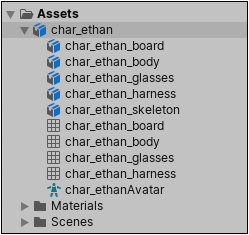
A successful match simply means that Unity was able to friction match all of the required bones. Notwithstanding, for better results, yous also need to friction match the optional bones and fix the model in a proper T-pose The pose in which the character has their arms straight out to the sides, forming a "T". The required pose for the character to exist in, in order to make an Avatar.
Encounter in Glossary .
If Unity can't create the Avatar, a cross appears next to the Configure button, and no Avatar sub-nugget appears in the Projection view.
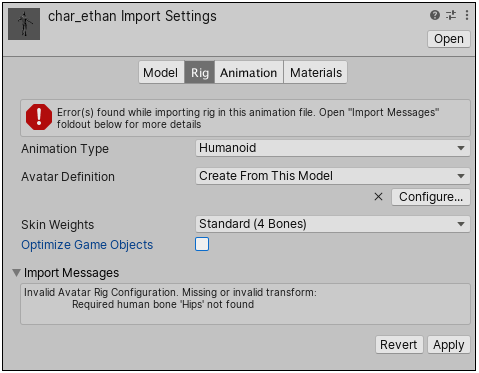
Since the Avatar is such an important aspect of the animation organization, it is important to configure it properly for your Model A 3D model representation of an object, such equally a character, a building, or a furniture. More info
See in Glossary .
For this reason, whether or non the automatic Avatar cosmos succeeds, you should always check that your Avatar is valid and properly set upward.
Configure the Avatar
If you lot desire to check that Unity correctly mapped your model'due south bones to the Avatar, or if Unity failed to create the Avatar for your model, yous tin can click the Configure … button on the Rig A skeletal hierarchy of joints for a mesh. More info
See in Glossary tab to enter the Avatar configuration mode.
If Unity successfully creates an Avatar, the Avatar appears as a sub-asset of the model Nugget. You can select the Avatar asset in the Projection window A window that shows the contents of your Assets folder (Projection tab) More than info
Encounter in Glossary , and then click the "Configure Avatar" button in the Inspector to enter the Avatar configuration mode. This mode allows to check or adjust how Unity maps your model's bones to the Avatar layout.

Once you have entered the Avatar configuration mode, the Avatar window appears in the Inspector A Unity window that displays data about the currently selected GameObject, asset or project settings, allowing you to inspect and edit the values. More info
See in Glossary displaying bone mapping.
Make certain the bone mapping is correct and that you map whatsoever optional bones that Unity did not assign.
Your skeleton needs to have at to the lowest degree the required bones in place for Unity to produce a valid match. In order to meliorate your chances for finding a lucifer to the Avatar, proper noun your bones in a way that reflects the body parts they represent. For example, "LeftArm" and "RightForearm" make it clear what these bones control.
Mapping strategies
If the model does not yield a valid lucifer, you tin use a similar process to the one that Unity uses internally:
- Choose Clear from the Mapping card at the bottom of the Avatar window to reset any mapping that Unity attempted.
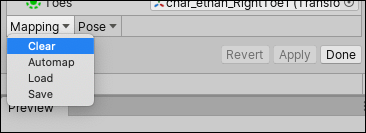
- Choose Sample Bind-pose from the Pose carte du jour at the lesser of the Avatar window to guess the Model's initial modeling pose.
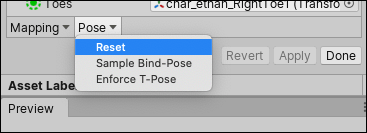
- Choose Mapping > Automap to create a bone-mapping from an initial pose.
- Choose Pose > Enforce T-Pose to set the Model back to to required T-pose.
If automapping fails completely or partially, you can manually assign bones by either dragging them from the Scene A Scene contains the environments and menus of your game. Think of each unique Scene file as a unique level. In each Scene, you lot place your environments, obstacles, and decorations, essentially designing and building your game in pieces. More info
Encounter in Glossary view or from the Hierarchy view. If Unity thinks a os fits, information technology appears in green in the Avatar Mapping tab; otherwise it appears in red.
Resetting the pose
The T-pose is the default pose required by Unity blitheness and is the recommended pose to model in your 3D modeling application. Still, if you lot did not use the T-pose to model your character and the animation does non work as expected, y'all can select Reset from the Pose driblet-down carte du jour:

If the bone assignment is correct, but the graphic symbol is not in the right pose, you will meet the message "Character non in T-Pose". You lot tin can try to prepare that past choosing Enforce T-Pose from the Pose menu. If the pose is still not correct, you can manually rotate the remaining bones into a T-pose.
Creating an Avatar Mask
Masking allows you to discard some of the animation information inside a clip, assuasive the clip to animate only parts of the object or character rather than the unabridged matter. For example, you may have a standard walking animation that includes both arm and leg move, merely if a character is conveying a large object with both hands then you wouldn't desire their arms to swing to the side equally they walk. Nevertheless, yous could notwithstanding apply the standard walking animation while carrying the object by using a mask to only play the upper torso portion of the carrying animation over the meridian of the walking animation.
You can apply masking to animation clips either during import fourth dimension, or at runtime. Masking during import time is preferable, because it allows the discarded blitheness data to exist omitted from your build, making the files smaller and therefore using less retentiveness. It also makes for faster processing because there is less animation data to be blended at runtime. In some cases, import masking may not be suitable for your purposes. In that case, you tin apply a mask at runtime by creating an Avatar Mask A specification for which body parts to include or exclude for an animation rig. Used in Animation Layers and in the importer. More info
Encounter in Glossary Asset, and using it in the layer settings of your Animator Controller Controls blitheness through Animation Layers with Animation State Machines and Animation Blend Trees, controlled by Animation Parameters. The same Animator Controller tin can be referenced by multiple models with Animator components. More than info
Run across in Glossary .
To create an empty Avatar Mask Asset, you can either:
- Cull Create > Avatar Mask from the Avails Any media or information that can be used in your game or project. An nugget may come from a file created outside of Unity, such as a 3D Model, an sound file or an image. You lot tin can also create some asset types in Unity, such as an Animator Controller, an Audio Mixer or a Render Texture. More info
See in Glossary card. - Click the Model object you lot want to define the mask on in the Projection In Unity, you employ a project to design and develop a game. A project stores all of the files that are related to a game, such as the nugget and Scene files. More info
See in Glossary view, and then right-click and choose Create > Avatar Mask.
The new Nugget appears in the Project view:
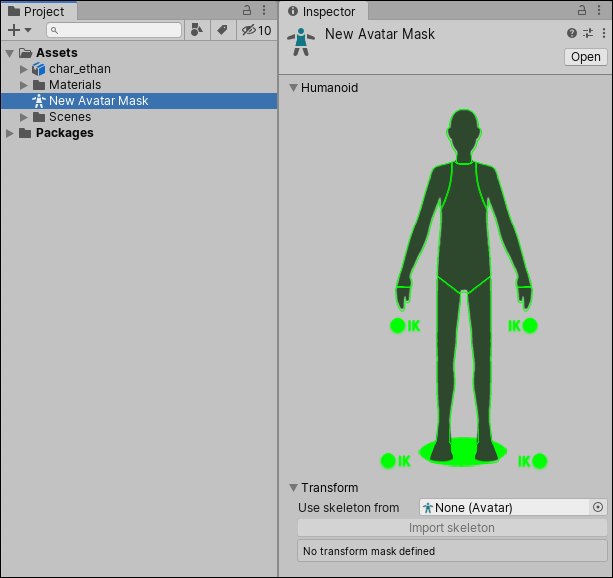
Y'all can now add portions of the torso to the mask and then add the mask to either an Animation LayerAn Animation Layer contains an Blitheness Country Auto that controls animations of a model or role of information technology. An example of this is if you lot have a full-body layer for walking or jumping and a higher layer for upper-torso motions such as throwing an object or shooting. The higher layers accept precedence for the body parts they control. More info
Come across in Glossary or add a reference to it nether the MaskCan refer to a Sprite Mask, a UI Mask, or a Layer Mask More info
See in Glossary section of the Blitheness tab.
Importing a model with non-humanoid (generic) animations
Source: https://docs.unity3d.com/Manual/ConfiguringtheAvatar.html